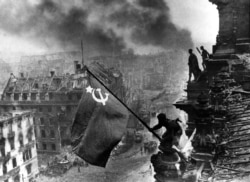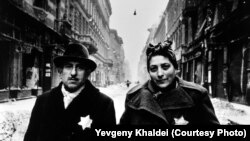The photo figures prominently at an exhibit of Khaldei's work currently on display at the Martin-Gropius-Bau exhibition hall in Berlin. Curator Ernst Volland says that of the 200 photographs featured in the "Decisive Moment" exhibit, the Reichstag image is the most famous.
"A lot of people know his pictures of the flag," Volland says. "It's one of the most reproduced photos in the world, of the 20th century. It's been in every schoolbook, more than [his photos] from the Potsdam conference and the Nuremberg trials. But nobody knew this name, Yevgeny Khaldei."
Volland and his partner Heinz Krimmer, who together own a collection of Khaldei's negatives, worked with Khaldei before his death in 1997. Some of the projects that Volland pursued with Khaldei included an opportunity for viewers to question the photographer directly about the Reichstag photograph.
As iconic as the image is, it has raised some controversy because it was staged. Khaldei recreated the event, using a handmade flag sewn by a tailor, and later added smoke to the photograph for dramatic effect, and airbrushed off one of two wristwatches worn by one of the soldiers, for fear the soldier would be branded a thief.
Volland, who has seen between 10,000 and 30,000 of Khaldei's negatives, says it was extremely rare for the photographer to manipulate his images to the degree seen in the Reichstag photo. Still, Volland argues, the fact that the picture has been staged does not alter its historic importance.
"In the 1990s, when I made small exhibitions with Khaldei in some cities in Germany, the first question to Khaldei after the show was: 'Is there something wrong with this photo? Is it a [recreation] or a montage, or something like that?'" Volland recalls. "And he always said, 'This is a good photo.' And I think he was right, because it's not really manipulated. It's his own flag on the Reichstag on May 2; it's not in the studio, it's not with model soldiers. He was there."
More Than Soviet Propaganda
While the exhibition lists Khaldei as a Russian photographer, he is more accurately described as a Soviet photographer. He was born in Ukraine to an Orthodox Jewish family, and throughout his life, worked for the Soviet press.
Khaldei was more than just a witness to some of the most tumultuous moments in the history of the USSR. He was also a victim of them. Born in the year of the Russian Revolution, Khaldei lost his mother the following year in the pogroms that swept through Ukraine. His father and other family members were killed by the Nazis in 1941. Khaldei himself was twice fired, by Tass and ""Pravda," for being Jewish.
Volland says while Khaldei's photography in many ways served to advance the interests of the Soviet regime, his images are often deeply emotional and cannot be dismissed as pure propaganda.
"In the war -- and not only in the war -- in every country, every photo is a propaganda photo, of course," he says. "But -- and this is a big but -- Khaldei was able to do it in a way that was absolutely not kitsch heroism. He showed people with all their suffering and all their pain. This was his main purpose."
In addition to his combat pictures, Khaldei photographed the Allied summit meetings at Potsdam and Yalta, as well as the Nuremberg trials of prominent Nazi officials.
After the war, Khaldei went on to photograph Josef Stalin and subsequent Soviet leaders. But many of his postwar subjects include ordinary workers at collective farms and factories.
Khaldei also documented everyday life juxtaposed against images of war: he photographed a sunbathing couple next to a destroyed building, a silhouette of a reindeer with fighter jets in the background, and a traffic director next to a sign with German towns written in Russian.
Khaldei, who died in relative obscurity, never received great acclaim during his lifetime, and many of his photographed images long went uncredited. Volland recalls a recent exchange in which a German official chided his Russian counterpart for failing to properly honor an artist of Khaldei's caliber.
"At the [exhibit] opening, the Minister of State Gernot Erler said to the Russian ambassador: 'Why is this so late? Why did you treat this big photographer so badly?'" Volland says. "He lived in a small one-room flat with 80 euros pension a month, and nobody even knew him. He was lost."
Volland comments on how Erler, who spoke at the opening, made note of the apparent contradiction in the fact that a German gallery is featuring photographs documenting Germany's defeat and the Soviet Union's success in the war.
The exhibition, which will remain in Berlin through the end of July, then moves on to Ukraine in the autumn, where viewers can appreciate a native son's gift for capturing the lives of ordinary people living in extraordinary times.
More Than Propaganda

Soviet photographer Yevgeny Khaldei, who was born in 1917 and died in 1997, was one of the Soviet Union's best-known photographers of the Great Patriotic War, documenting Soviet advances Belgrade, Budapest, Vienna, and Berlin. More than a half-century later, Khaldei's images -- some of which were staged -- remain a subject of fascination and controversy.









